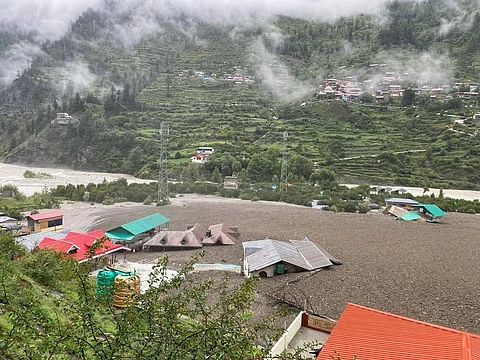
- Destinations
- Experiences
- Stay
- What's new
- Celebrating People
- Responsible Tourism
- CampaignsCampaigns
- SubscribeSubscribe
- Buy Now

At least four people were killed and dozens are still missing in the Uttarkashi district of Uttarakhand after flash floods triggered by a cloudburst hit the Kheer Ganga River on Tuesday afternoon (August 5).
The floods hit hotels and residential buildings in Dharali village, situated 8,600 ft above sea level. Video footage recorded by residents showed giant waves of water gushing through the area and swallowing everything in their way, including people and homes.
Heavy rain continued to pound Uttarkashi as rescuers resumed their operations on Wednesday, August 6, in Dharali, searching for flash flood victims amid the rubble.
Uttarakhand Chief Minister Pushkar Singh Dhami surveyed an ongoing high-intensity rescue operation involving the Indian Army, the Indo-Tibetan Border Police, the State Disaster Response Force (SDRF), the National Disaster Response Force (NDRF) and local residents. The latest reports say that 150 people have already been saved.
In Himachal Pradesh, 413 pilgrims stranded along the Kinnaur Kailash Yatra route were rescued.
Studies have found an increase in extreme rainfall events in India in recent decades as global temperatures have risen. According to the Centre for Science and Environment (CSE), India faced extreme weather events on 93 per cent of the days in the first nine months of 2024—255 out of 274 days—marked by heat and cold waves, cyclones, lightning, heavy rain, floods and landslides. These events claimed 3,238 lives, affected 3.2 mha of crops, destroyed 235,862 houses and buildings and killed approximately 9,457 livestock.
Pradeep Sangwan, the founder of the Healing Himalayas Foundation, an organisation that protects the Himalayan ecosystem from waste pollution and the effects of the climate crisis, has noticed that natural phenomena like cloudbursts have become more frequent in the last decade.
“The downpour has increased a lot. That is one of the scary facts that we are facing,” he says. “Every second day in the monsoon we are seeing cloudbursts happening. The India Meteorological Department (IMD) said that this year's monsoon will be heavier and longer, but I don’t think anyone can be prepared for a cloudburst of this magnitude. These are natural phenomena turning into natural disasters.”
As Outlook Traveller reported previously, a cloudburst is a sudden occurrence of very heavy rainfall that is usually local in nature and of a brief duration. Technically speaking, an event can be deemed to be a cloudburst if rainfall of 10 cm or more falls in an hour over a roughly 10 km x 10 km area.
Cloudbursts are more common in hilly areas because of a phenomenon called orographic lift, where warm air rises up the side of a mountain. Nearly all recorded cloudbursts in the Indian subcontinent occur when monsoon clouds drift from the Arabian Sea to the Himalayas.
Sangwan says the increase in extreme weather events in India’s Himalayan states and union territories is directly impacting tourism to the region. His own team, which was based at the Yamunotri Base Camp, had to be evacuated after cloudbursts and landslides occurred in the region.
“The tourism [to Uttarakhand and Himachal Pradesh] is dead for a good two months. For the last one-and-a-half months, I have been connected with multiple hoteliers in Himachal, who have said there is almost zero business coming in,” he says.
“The Healing Himalayas Foundation’s team has had to postpone our on-ground activities for a month. But we are not sure [when we will resume] because everywhere things are changing.”
These “dead” tourism months lead to an increase in visitors during safer months of the year, resulting in many environmental and economic issues that Sangwan says need to be talked about more.
“Take for the example the 20-30 lakh pilgrims that visit the Kedarnath temple every year from May to early November. About 50 per cent of the footfall happens in May and June when the weather is good. During the monsoon season of July and August, no one wants to travel because it is very risky. This creates a lot of local problems,” he says.
“The hotels are overbooked. When they are free, they are so free that they have nothing to do, but when they are busy, [they are in overdrive].
“This creates a lot of environmental issues also because every place has a carrying capacity. The carrying capacity has to be divided equally into every month, but that is not possible because everyone wants to go at a particular time when there is suitable weather and when it’s pocket-friendly.”
The impact on rural communities whose livelihoods depend upon tourism can be devastating then. So, what can travellers do to help the people in the places they love?
Sangwan suggests the building of forums and platforms that support Himalayan residents during times of crisis is one way to lend a helping hand to residents.
“We should be ready to help the local communities, the state governments and the state disaster management departments when such events occur. Responsible tourism communities must create a forum for disaster management where they supply raw material wherever it’s required,” he says.
“People on ground can always identify who has been hit the most. I’m not saying that we can save the whole valley or that we can save the whole village, but a small part of it can be brought in. Being a responsible traveller, it will reflect into our goodwill also.”
